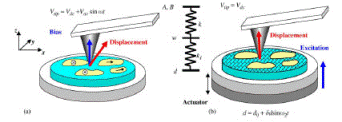Department of Physics and Astronomy: Publications and Other Research
Date of this Version
1-1-2006
Abstract
The majority of calcified and connective tissues possess complex hierarchical structure spanning the length scales from nanometers to millimeters. Understanding the biological functionality of these materials requires reliable methods for structural imaging on the nanoscale. Here, we demonstrate an approach for electromechanical imaging of the structure of biological samples on the length scales from tens of microns to nanometers using piezoresponse force microscopy (PFM), which utilizes the intrinsic piezoelectricity of biopolymers such as proteins and polysaccharides as the basis for high-resolution imaging. Nanostructural imaging of a variety of protein-based materials, including tooth, antler, and cartilage, is demonstrated. Visualization of protein fibrils with sub-10 nm spatial resolution in a human tooth is achieved. Given the near-ubiquitous presence of piezoelectricity in biological systems, PFM is suggested as a versatile tool for micro- and nanostructural imaging in both connective and calcified tissues.


Comments
Published in Journal of Structural Biology 153 (2006) 151–159. doi:10.1016/j.jsb.2005.10.008. Copyright 2006. Used by permission.